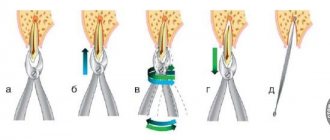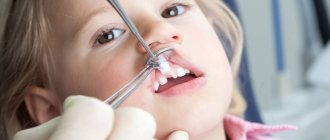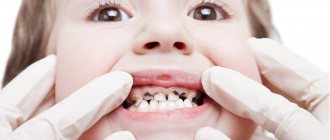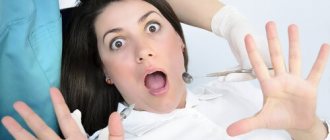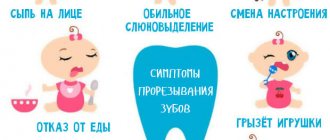Should you take your child to the dentist or remove a baby tooth at home? All parents face this dilemma. So what's the best thing to do? There is no clear answer to this question. Naturally, as a doctor, I will advise you to go to a dentist so that he can remove your child’s tooth under sterile conditions and without pain.
However, this does not always happen. Often, either children are absolutely afraid to go to the doctor, or the tooth is about to be “ready,” or, for example, you are at work from morning to night and it seems that the problem is trivial. In this case, I’ll tell you about ways that will help you safely pull out a baby tooth without leaving home and without exposing your baby to stress.
Content:
- Are baby teeth pulled out?
- How to remove a baby tooth yourself
- Removal technique
- If teeth are removed too early
- If you had to remove several neighboring units prematurely
- Caring for the child's psyche
Removing children's teeth is an exciting event for both the child and his parents.
All mothers and fathers want the manipulation to be absolutely painless. And it’s better if everything happens at home. But you should not focus on pulling out incisors, canines and molars at home. If there are indications for the removal of a loose baby tooth, but the child does not want or cannot loosen it on his own, he should make an appointment with pediatric dentistry.
Here, thanks to the use of modern topical anesthetics and pain-relieving sprays , surgery takes place without pain and is almost invisible to the baby. While the doctor removes a baby tooth, the little patient calmly watches his favorite cartoon.
Preparing the child
When the tooth is already loose enough to interfere with the child, you can proceed to the extraction procedure.
Some parents (on the advice of “all-knowing” grandmothers) try to do this suddenly, asking the baby to open his mouth so that the mother can “just look at the tooth.”
Most often, the result of such actions is predictable: tears, hysteria, panic fear of toothache and loss of trust not only in parents, but in the whole world - after all, if mom deceived, then others can do the same too.
That is why it is important to talk frankly with the baby, psychologically preparing him for the removal procedure:
- Explain that he has grown up, so his baby teeth, which are intended for babies, fall out, leaving room for new, strong “adult” teeth. But in order for them to grow up even and beautiful, you need to help them a little by taking out an “old” tooth from the gum.
- You shouldn’t assure your baby that “it won’t hurt at all” - after all, this is not true, and having felt unpleasant sensations, the baby will also feel offended that he was deceived. It’s better to say that it will be unpleasant, and perhaps even painful, but very quickly, and it’s worth being a little patient.
- Be sure to tell your little one an exciting story about the magical Tooth Fairy, who takes away the baby tooth placed under the pillow, leaving coins, toys or other pleasant surprises in return.
Together with your child, you can make a chest for a tooth, draw a picture, or write a letter to the Fairy describing the desired gift. This activity will distract the little one, putting her in a positive mood.
Are baby teeth pulled out?
Extraction of temporary units is carried out if there are medical indications for this. If the change takes place in a timely manner, no curvature of the dentition is observed; there is no need to loosen the teeth ahead of time, as this is fraught with malocclusion in the future.
The procedure cannot be avoided if:
- caries has become so rampant that all that remains of the crown are the roots;
- for some reason, urgent dental treatment cannot be performed;
- The permanent tooth has already erupted, but the milk tooth is still sitting in its place;
- flux has developed, body temperature is elevated, the patient is worried about acute pain;
- a cyst has formed on the root;
- in the gum area a fistula filled with purulent contents is visualized;
- periodontitis has been diagnosed, which can provoke the death of the permanent tooth germ;
- root resorption occurs with a delay, which poses a threat to permanent occlusion.
Extraction is also carried out if the tooth is very loose, but does not fall out. This leads to the fact that the child cannot eat normally and has a lisp.
How to remove a baby tooth yourself
On the Internet you can find many ways to quickly pull out a loose tooth. Let us immediately make a reservation that for the most part they are unsafe and very often lead to serious psychological trauma.
So, if the procedure of pulling out the thread is unsuccessful (and this happens very often), the baby will be very scared. Subsequently, he will categorically refuse to open his mouth. Then even the simplest dental procedures will be impossible, emerging oral diseases will progress and it is possible that in the future they will have to be treated under anesthesia.
Therefore, dentists urge parents not to look for ways to remove a baby tooth at home, but to seek qualified dental care. Then everyone will be healthy and happy - mom, dad and child.
The only thing that can be done at home is to tell the offspring to diligently loosen the tooth and periodically treat it with carrots, apples, crackers in the hope that while chewing solid food the dentogingival connection can be weakened.
Preparatory stage
Feed your baby before the procedure!
As soon as the tooth hangs on a thread-like basis, no pain is felt when loosening to the sides, you can plan the extraction procedure. You should first examine your mouth to make sure there is no inflammation or swelling.
During preparation, it is worth feeding the child, because after the manipulations you should not eat for 2-3 hours.
After this, brush your teeth with paste and brush. You can also use additional rinse aid. All funds used are prepared in advance. They need to be disinfected with high temperature or antiseptic. A set of specific materials is collected depending on the method of tooth extraction used.
Removal technique
When deciding how to extract a baby tooth, dentists look at the degree of its mobility and location. The intervention is carried out very carefully. This is due to some structural features of children's teeth. For example, they have very thin and very long alveolar walls, and short roots. Therefore, when gripping, it is important not to press too hard to prevent the crown from cracking.
Particular attention is paid to the issue of selection of anesthesia. For severe mobility, a local application is suitable. It involves treating the gums in the area where the affected unit is located. If the loosening is very weak or completely absent, an injection is given to achieve a stronger and more lasting anesthetic effect.
When can you pull out at home?
When a tooth begins to wobble, this means that its roots are dissolving and removing it from the gums will not be difficult.
However, the guarantee of a painless procedure is the maximum loosening of the tooth so that it does not tilt slightly, but literally lies in different directions.
To do this you can:
- ask the baby to independently loosen the tooth with his tongue or fingers (after washing his hands and picking it up with a cotton swab or a piece of bandage);
- Offer your baby solid treats: apples, nuts, carrots, or even toffees.
If teeth are removed too early
Pulling out is considered premature when there is more than a year left before the natural change of teeth. In this case, the “neighbors” manage to occupy the vacated space, and there is no space left for the eruption of the future molar, incisor or molar.
As a result, the likelihood of developing a malocclusion . It is possible that you will have to wear braces as a teenager. Therefore, there is no need to rush to pull it out. The operation is only permissible if there are medical indications for its implementation.
If you had to remove several neighboring units prematurely
This happens due to traumatic damage to the upper or lower jaw, or parents ignoring the child’s serious dental problems. If the planned change of removed units is more than one or two years away, special children's dentures should be made. Usually these are plates that need to be worn during the day to prevent negative changes in the bite.
Plastic or metal retainers should be used until permanent teeth begin to emerge. Only then can they be abandoned.
Procedure
So what to do:
- Before proceeding with the removal, the child must be well fed, because after the procedure it is not recommended to eat for at least a couple of hours.
- Then you need to thoroughly brush your baby’s teeth so that food debris and bacteria after removal do not penetrate the wound and cause an inflammatory process.
- If the child is very afraid of pain, you can give him an anesthetic (for example, ibuprofen) in an age-appropriate dosage twenty to thirty minutes before the procedure. As an option, you can use gels that make teething easier: they seem to freeze the gums, significantly reducing pain. They must be applied immediately before removal.
- Before the procedure, the adult washes their hands thoroughly, if possible disinfecting them with an antibacterial agent. After this, you can start deleting. The World Wide Web offers many options for extracting baby teeth, from funny to dangerous. However, the two that have taken root the most and are most often used are: manual and using thread.
The manual method makes it possible to control one’s own movements, applying effort if necessary: the tooth is covered with a piece of bandage (gauze), tightly grasped with fingers (thumb and forefinger), after which with a sharp and firm movement (around its axis and slightly towards itself) it is removed from the gums.
Removal with a thread is as follows: about forty centimeters of strong (silk or nylon) thin thread is measured, which is folded in half and draped over the tooth to be removed using a simple tightening knot.
It is important to ensure that no part of the gum gets between the tooth and the floss, which could be injured during the removal process.
Then you need to sharply pull the thread in the opposite direction: if the tooth is upper, the trajectory of movement should go down, respectively, the lower jaw unit should be removed in an upward direction.
As an option, you can tie a thread to the door handle and then suddenly open the door. In this case, you need to make sure that the baby’s mouth is wide open, and the head is slightly tilted down (when removing the lower tooth) or raised (when extracting the upper one).
After extracting the tooth, you need to put a sterile piece of bandage on the resulting empty space and ask the baby to close his teeth. Let him sit quietly with such a tampon in his mouth for some time (usually 15 minutes, or until the blood stops oozing), watching an interesting cartoon or listening to his favorite fairy tale.
Caring for the child's psyche
So that over the years the child does not turn into an adult who trembles at the mere word “dentist,” you must definitely find a doctor for him who inspires confidence. A lot depends on the professionalism of the child specialist. Not the least important factor in preparing for a problem-free extraction is the attitude of the parents. They should remain calm and distract the baby, and not irritate him. It is imperative that mom or dad be with the child in the dental office.
Do not ignore the importance of baby teeth in the formation of a permanent bite. Treat them promptly in your child. Then his smile will always be healthy and beautiful.
Stopping bleeding after removal
After a baby tooth is removed, there may be some bleeding. It can be stopped by applying turunda from a bandage to the wound. This stops the bleeding within 1-3 minutes.
If the bleeding does not stop within 30 minutes or more, you should consult a doctor. Medical help should also be sought in cases where complications occur. For example, these are swelling and redness of the gums, suppuration, infection, as well as remaining fragments of teeth in the gums.
